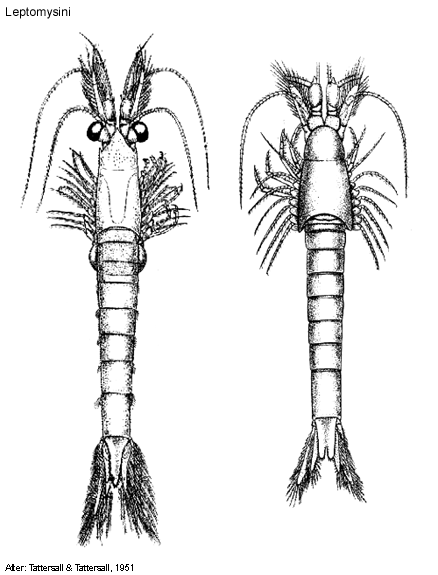 |
||||||
|
|
|
|
|
|
Mysidacea: Families, Subfamilies and TribesKenneth MelandLeptomysini Hansen, 1910 Diagnostic description. Head. Carapace large, last 2 or 3 thoracic somites exposed dorsally. Rostrum obtuse, or broadly rounded. Eyes normally developed (in Bathymysis the compound eyes have been reduced to two plate-likes structures similar to that found in the Erythropini genus Amblyops). Antenna (antenna 2) scale with apical suture or without apical suture, outer margin smooth, setose, without terminal spine. Labrum symmetric. Mandible lacinia mobilis well developed, spine row present between lacinia mobilis and molar process, molar process well developed. Thorax. 1st maxilliped exopod well developed. 2nd thoracopod developed as a maxilliped, exopod well developed. 3rd-8th thoracopods endopod with fused carpus and propodus (tarsus), carpopropodus divided into a few subsegments. Branchiae on thoracopods absent. Marsupium composed of three pairs of oostegites. Abdomen 6th & 7th abdominal somites fused. 1st pair endopod reduced; 2nd pair biramous; 3rd pair biramous; 4th pair biramous, or modified exopod (either elongated or terminating in a thickened spine); 5th pair biramous. Female pleopods uniramous or greatly reduced. Uropod endopod setose around entire margin or inner margin with robust setae, statocyst present; exopod complete, setose around entire margin. Telson apex entire, or apex cleft. Generic composition. Leptomysini contains 31 genera (170 species): Afromysis Zimmer, 1916 (6 species); Americamysis Price, Heard & Stuck, 1994 (6 species); Antichthomysis Fenton, 1991 (1 species); Australomysis W. Tattersall, 1927 (5 species); Bathymysis W. Tattersall, 1907 (2 species); Brasilomysis Bacescu, 1968 (2 species); Calyptomma W. Tattersall, 1909 (1 species); Cubanomysis Bacescu, 1968 (2 species); Dioptromysis Zimmer, 1915 (5 species); Doxomysis Hansen, 1912 (15 species); Harmelinella Ledoyer, 1989 (1 species); Hyperiimysis Nouvel, 1966 (1 species); Iimysis Nouvel, 1966 (2 species); Leptomysis G.O. Sars, 1869 (1 species); Megalopsis Panampunnayii, 1987 (1 species); Metamysidopsis W. Tattersall, 1951 (8 species); Mysideis G.O. Sars, 1869 (2 species); Mysidetes Holt & Tattersall, 1906 (16 species); Mysidopsis G.O. Sars, 1864 (47 species); Mysifaun Wittmann, 1996 (1 species); Neobathmysis Bravo & Murano, 1996 (2 species); Notomysis Wittmann, 1996 (1 species); Nouvelia Bacescu & Vasilescu, 1973 (3 species); Paraleptomysis Liu & Wang, 1983 (5 species); Prionomysis W. Tattersall, 1922 (3 species); Promysis Dana, 1850 (2 species); Pseudomysis G.O. Sars, 1879 (2 species); Pseudoxomysis Nouvel, 1973 (1 species); Pyroleptomysis Wittmann, 1985 (2 species); Rostromysis Panampunnayii, 1987 (1 species); Tenagomysis Thomson, 1900 (13 species). Remarks. The majority of the Leptomysini are found to prefer a hard bottom littoral habitat, and are distributed worldwide. Larger genera such as Leptomysis and Mysidetes contain specialized cave-dwelling species, while other genera such as Bathymysis and Pseudomysis are strictly mesobathypelagic. The Leptomysini are recognized by the antennal scale being lanceolate and setose around entire margin, and the third to eigth endopods of the thoracopods having the carpus and propodus fused and divided into smaller subsegments.
Cite this publication as: 'Meland, K. (2002 onwards). Mysidacea: Families, Subfamilies and Tribes. Version 1: 2 October 2002. https://crustacea.net'. |
|
|
|
|
|
|
|
|
|
Copyright © Australian Museum, 2002 - 2003
Australian Museum website
